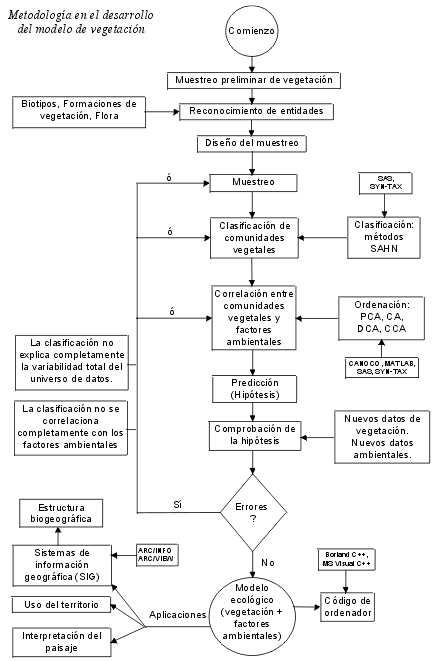Research Interest
Key Words
Biodiversity. Bioclimatic Models. Biogeographic Models. Bioindicators Analysis. Classification and Ordination of Plant Communities. Ecological Models. Environmental Variables. Geographic Information Systems. Multivariate Data Analysis. Plant Cartography. Plant Ecology. Plant Taxonomy. Vegetation Mapping. Vegetation Science.
Introduction
My research interest deals with plant communities classification, bioclimatology, biogeography, and ecological models. Ecological models look for relationships between organisms and environmental variables, showing their distribution patterns, and predicting their ecological behavior.
Methodology
Field sampling
Field sampling most frequently used is the Centralized Replicate Sampling Procedure (Mueller-Dombois & Ellenberg 1974), very useful when looking for regional geographic models. Sampling locations are chosen in areas of homogeneous vegetation, according to plant-forms and physiognomic-ecological plant formations (Box 1981).
Classification
Description of homogeneous plant communities is a complex task in plant ecology, phytosociology, phytogeography, phytoclimatology, and landscape ecology (see Dufrene & Legendre 1991). Sequential, Agglomerative, Hierarchical, and Non-overlapping clustering techniques (SAHN, Sneath & Sokal 1973) classify the data in function of floristic composition and community structure. Plant communities described this way might be used as ecological bioindicators.
Ordination
Vegetation units defined by cluster analysis are superimposed on ordination diagrams in order to provide a more complete analysis of the grouping, and and to analyze relationships between vegetation, flora, and environmental variables (climate, substrate, snow cover, salinity, and so forth). Most common analyses are Principal Components Analysis (Moreno et al. 1990, Peinado et al. 1995), Correspondence Analysis (CA, Hill 1973, ter Braak 1985, Molina Abril et al. 1999, Sardinero 2000), Detrended Correspondence Analysis (DCA, Hill & Gauch 1980, Walker et al. 1994), and Canonical Correspondence Analysis (CCA, ter Braak 1986, 1987, Retuerto & Carballeira 1991, 1992, Hill 1991, Palmer 1993).
Results
When plant communities have been related to a variety of environmental variables, a biogeographic model is yielded that it is tested and progressively improved. Information might be entered in Geographic Information Systems (GIS), analysed and mapped.
References
- Box, E.O. 1981. Macroclimate and Plant Forms: An Introduction to Predictive Modeling in Phytogeography. The Hague, Boston, and Hingham, Mass. [Tasks for Vegetation Science, vol. 1].
- Dufrene, M. & Legendre, P. 1991. Geographic structure and potential ecological factors in Belgium. J. Biogeog. 18: 257-266.
- Hill, M.O. 1973. Reciprocal averaging: an eigenvector method of ordination. J. Ecol. 61: 237-249.
- Hill, M.O. 1991. Patterns of species distribution in Britain elucidated by canonical correspondence analysis. J. Biogeog. 18: 247-255.
- Hill, M.O. & Gauch, H.G. 1980. Detrended correspondence analysis: An improved ordination technique. Vegetatio 42: 47-58.
- Molina Abril, J.A., Sardinero, S. & Pertíñez, C. 1999. Littorellion communities in Spain. Folia Geobot 34: 253-260. Praha.
- Moreno, J.M., Pineda, F.D. & Rivas-Martínez, S. 1990. Climate and vegetation at the Eurosiberian-Mediterranean boundary in the Iberian Peninsula. J. Veg. Sci. 1: 233-244.
- Mueller-Dombois, D. & Ellenberg, H. 1974. Aims and methods of vegetation ecology. J. Wiley and Sons, New York.
- Palmer, M.W. 1993. Putting things in better order: the advantages of canonical correspondence analysis. Ecology 74(8): 2215-2230.
- Peinado, M., Alcaraz, F., Aguirre, J.L. & Delgadillo, J. 1995. Major plant communities of warm North American deserts. J. Veg. Sci. 6: 79-94. 1995.
- Retuerto, R & Carballeira, A. 1991. Defining phytoclimatic units in Galicia, Spain, by means of multivariate methods. J. Veg. Sci. 2: 699-710.
- Retuerto, R & Carballeira, A. 1992. Use of Direct gradient analysis to study the climate-vegetation relationships in Galicia, Spain. Vegetatio 101: 183-194.
- Sardinero, S. 2000. Classification and ordination of plant communities along an altitudinal gradient on the Presidential Range, New Hampshire, USA. Plant Ecology.
- Sneath, P. & Sokal, R. 1973. Numerical taxonomy. Freeman, San Francisco, California.
- ter Braak, C.J.F. 1985. Correspondence analysis of incidence and abundance data: properties in terms of a unimodal response model. Biometrics 41: 859-873.
- ter Braak, C.J.F. 1986. Canonical correspondence analysis: a new eigenvector technique for multivariate direct gradient analysis. Ecology 67: 1167-1179.
- ter Braak, C.J.F. 1987. The analysis of vegetation-environment relationships by canonical correspondence analysis. Vegetatio 69: 69-77.
- Walker, M.D., Walker, D.A. & Auerbach, N.A. 1994. Plant communities of a tussock tundra landscape in the Brooks Range Foothills, Alaska. J. Veg. Sci. 5: 843-866.
[Back to Top]
Methodologic Flowchart

[Back to Top]
Links to Interesting Pages
Ecology:
Climatic Change:
Associations, Societies, Centers:
Ecological Data Analysis:
[Back to Top]

|

|
Last update: 11/04/2002
|

